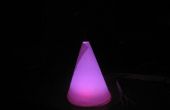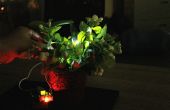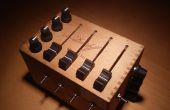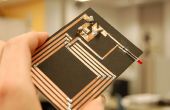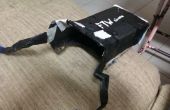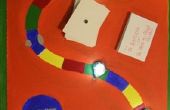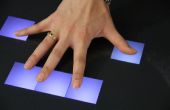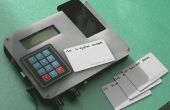Stap 7: Program je Board
De volgende code kunt u het programma van je Teensy board verzenden van MIDI naar uw computer. U kunt ook de code op GitHub downloaden.
int bounceThreshold = 0; // a press must last this many loop cycles (about 20ms each) before triggering. // higher values make it less sensitive, fewer false triggers, higher latency#define NUM_INPUTS 44int channel = 1;// edit this array to change the MIDI notes sent //int pitches[NUM_INPUTS] = { // 79, 84, 75, 67, 65, 63, // top of board (up, left, down, right, space, click) // 60, 62, 77, 68, 58, 56, // left side of female header, w,a,s,d,f,g // 51, 53, 48, 55, 72, 74 // right side of female header, up,down,left,right,left-click,right-click //};// teensy makey pin numbers int pinNumbers[NUM_INPUTS] = { 0,1,2,3,4,5,7,8,9,10,11,12,13,14,15,16,17, // left side starting at USB connector, pin D0, skipping D6 26,25,24,23,22,21,20,19,18,38,39,40,41,42,43,44,45, // right side starting at USB connector, pin B6, skipping gnd and aref 36,37,32,33,34,35,28,29,30,31 // these are "interior" through-holes, in the center of the board };// cap sense thresholds for each pin // this is proportional to the capacitance on the pin that will count as a press // it is units of a very small unit of time, in iterations through an unrolled loop // higher values make it less sensitive (i.e. require larger capacitance) //int capThresholds[NUM_INPUTS] = { // 1, 1, 1, 1, 1, 2, // 2, 2, 1, 1, 1, 1, // 2, 1, 1, 1, 1, 1, //};int bounceCounter[NUM_INPUTS]; boolean pressed[NUM_INPUTS];void setup(){ for (int i=0; ivoid loop() { for (int i=0; i1){ // if we detect a touch on the pin if (!pressed[i]) { // and if we're not already pressed bounceCounter[i]++; // increment the bounce counter if(bounceCounter[i] > bounceThreshold){ // if we're over the bounce threshold usbMIDI.sendNoteOn(60+i,127,channel); // send a MIDI note on pressed[i] = true; // remember it was pressed bounceCounter[i]=0; // reset the bounce counter } } } else { // if we don't a detect touch on the pin if (pressed[i]) { // if this key was pressed before usbMIDI.sendNoteOff(60+i,127,channel); // send a MIDI note off pressed[i] = false; // remember we are not pressed bounceCounter[i] = 0; // reset the bounce counter } } } //Serial.println(" "); } // CapacitiveSensor tutorial from http://www.arduino.cc/playground/Code/CapacitiveS... // readCapacitivePin // Input: Arduino pin number // Output: A number, from 0 to 17 expressing // how much capacitance is on the pin // When you touch the pin, or whatever you have // attached to it, the number will get higheruint8_t readCapacitivePin(int pinToMeasure) { // Variables used to translate from Arduino to AVR pin naming volatile uint8_t* port; volatile uint8_t* ddr; volatile uint8_t* pin; // Here we translate the input pin number from // Arduino pin number to the AVR PORT, PIN, DDR, // and which bit of those registers we care about. byte bitmask; port = portOutputRegister(digitalPinToPort(pinToMeasure)); ddr = portModeRegister(digitalPinToPort(pinToMeasure)); bitmask = digitalPinToBitMask(pinToMeasure); pin = portInputRegister(digitalPinToPort(pinToMeasure)); // Discharge the pin first by setting it low and output *port &= ~(bitmask); *ddr |= bitmask; delay(1); // Make the pin an input with the internal pull-up on *ddr &= ~(bitmask); *port |= bitmask; // Now see how long the pin to get pulled up. This manual unrolling of the loop // decreases the number of hardware cycles between each read of the pin, // thus increasing sensitivity. uint8_t cycles = 17; if (*pin & bitmask) { cycles = 0; } else if (*pin & bitmask) { cycles = 1; } else if (*pin & bitmask) { cycles = 2; } else if (*pin & bitmask) { cycles = 3; } else if (*pin & bitmask) { cycles = 4; } else if (*pin & bitmask) { cycles = 5; } else if (*pin & bitmask) { cycles = 6; } else if (*pin & bitmask) { cycles = 7; } else if (*pin & bitmask) { cycles = 8; } else if (*pin & bitmask) { cycles = 9; } else if (*pin & bitmask) { cycles = 10; } else if (*pin & bitmask) { cycles = 11; } else if (*pin & bitmask) { cycles = 12; } else if (*pin & bitmask) { cycles = 13; } else if (*pin & bitmask) { cycles = 14; } else if (*pin & bitmask) { cycles = 15; } else if (*pin & bitmask) { cycles = 16; } // Discharge the pin again by setting it low and output // It's important to leave the pins low if you want to // be able to touch more than 1 sensor at a time - if // the sensor is left pulled high, when you touch // two sensors, your body will transfer the charge between // sensors. *port &= ~(bitmask); *ddr |= bitmask; return cycles; }

